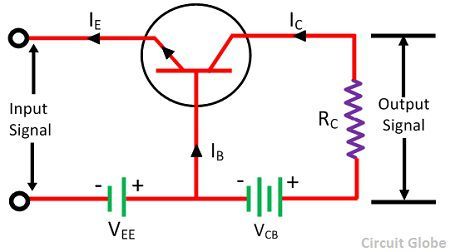The transistor raises the strength of a weak signal and hence acts an amplifier. The transistor amplifier circuit is shown in the figure below. The transistor has three terminals namely emitter, base and collector. The emitter and base of the transistor are connected in forward biased and the collector base region is in reverse bias. The forward bias means the P-region of the transistor is connected to the positive terminal of the supply and the negative region is connected to the N-terminal and in reverse bias just opposite of it has occurred.
The input signal or weak signal is applied across the emitter base and the output is obtained to the load resistor RC which is connected in the collector circuit. The DC voltage VEE is applied to the input circuit along with the input signal to achieve the amplification. The DC voltage VEE keeps the emitter-base junction under the forward biased condition regardless of the polarity of the input signal and is known as a bias voltage.
When a weak signal is applied to the input, a small change in signal voltage causes a change in emitter current (or we can say a change of 0.1V in signal voltage causes a change of 1mA in the emitter current) because the input circuit has very low resistance. This change is almost the same in collector current because of the transmitter action.
In the collector circuit, a load resistor RC of high value is connected. When collector current flows through such a high resistance, it produces a large voltage drop across it. Thus, a weak signal (0.1V) applied to the input circuit appears in the amplified form (10V) in the collector circuit.


Very useful information maam
Good explanation of transistor as an amplifier
Very useful thank you madam
Very useful and good explanation.
Nice explanation of this topic
Thanks 😘
Thank you maam
it’s a wonderful explanation tnks alot mam